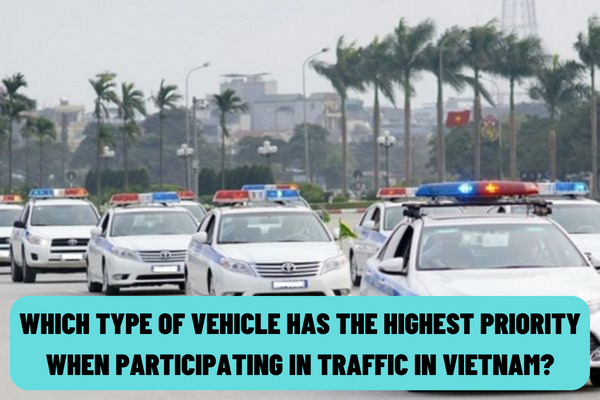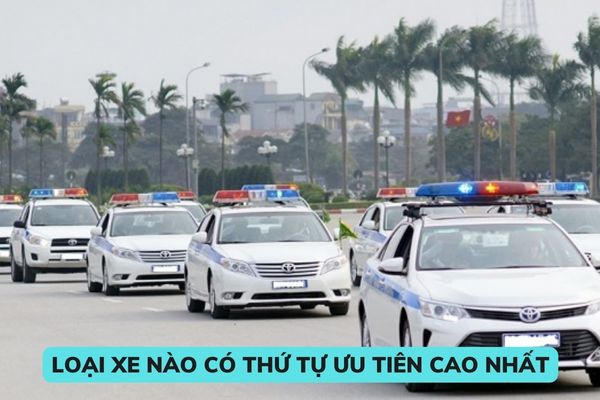Which type of vehicle has the highest priority when participating in traffic in Vietnam? How much is the fine for overtaking a priority vehicle when participating in traffic?
Which type of vehicle has the highest priority when participating in traffic in Vietnam?
In Article 22 of the 2008 Law on Road Traffic in Vietnam, there are provisions on the right of priority of certain types of vehicles when participating in traffic as follows:
Priority rights of a number of vehicles
1. The following vehicles have the priority right to go before other vehicles when passing intersections from any direction of traffic in the following order:
a/ Fire engines traveling on duty;
b/ Military vehicles and police vehicles on urgent duty; motorcades led by police cars;
c/ Ambulances on duty;
d/ Dike-watch vehicles, vehicles employed in overcoming natural disasters or epidemics or in a state of emergency as prescribed by law;
e/ Funeral vehicle processions.
2. Vehicles specified at Points a, b, c and d of Clause 1, this Article, when traveling on duty, shall give signals by means of horn, banner and light according to regulations; are not restricted in speed; may enter one-way roads from the opposite direction and other roads open to traffic, even go through the red light, and must only follow the instructions of persons directing traffic.
The Government shall issue specific regulations on signals of priority vehicles.
3. When recognizing the signals of priority vehicles, road users shall promptly slow down, give way or pull in to the right edge of the carriageway to give way. They may not obstruct priority vehicles.
Thus, according to current regulations, fire engines traveling on duty will be the vehicle with the highest priority when participating in traffic, the fire engines traveling on duty are not restricted in speed; may enter one-way roads from the opposite direction and other roads open to traffic, even go through the red light.

Which type of vehicle has the highest priority when participating in traffic in Vietnam? How much is the fine for overtaking priority vehicle when participating in traffic? (Image from the Internet)
Is it possible to overtake priority vehicles when participating in traffic?
Article 14 of the 2008 Law on Road Traffic in Vietnam provides for overtaking as follows:
Overtaking
1. Before overtaking a vehicle shall give a signal by means of light or horn; from 22.00 hrs to 05.00 hrs in urban centers and populous areas, only light signals can be used for this purpose.
2. The overtaking vehicle may overtake only where there is no obstacle ahead, no oncoming vehicle in the road section intended for overtaking and the vehicle ahead has not given a signal to overtake another and has moved toward the right side.
3. When there is a vehicle intending to overtake, if safety can be assured, the operator of the vehicle ahead shall slow down, move close to the right of the carriageway till the following vehicle has passed and may not cause obstructions to the overtaking vehicle.
4. When overtaking, a vehicle shall do so on the left side, except for the following cases where it can overtake on the right side:
a/ When the vehicle ahead has given a signal to turn left or is turning left;
b/ When a tram is running in the middle of the road;
c/ When a special-use vehicle is operating on the road, making overtaking on the left impossible.
5. Overtaking is forbidden in the following cases:
a/ The conditions prescribed in Clause 2 of this Article are not met;
b/ There is only a single line of vehicular traffic on a narrow bridge;
c/ On a bend, at the crest of a slope and at a place with insufficient visibility;
d/ At an intersection or a level crossing between a road and a railroad track;
e/ When weather conditions or road conditions do not ensure safe overtaking;
f/ A priority vehicle is emitting a priority signal.
Thus, the priority vehicle that is emitting a priority signal to travel on duty in the case that it is not allowed to overtake, the person who overtakes the priority vehicle that is emitting a priority signal to travel on duty may be fined.
How much is the fine for overtaking priority vehicles when participating in traffic?
In Clause 5, Article 5 of Decree No. 100/2019/ND-CP, as amended by Article 2 of Decree No. 123/2021/ND-CP, stipulating penalties imposed upon operators of cars and car-like vehicles violating traffic rules as follows:
Penalties imposed upon operators of cars and car-like vehicles violating traffic rules
…
5. A fine ranging from VND 3,000,000 to VND 5,000,000 shall be imposed upon a vehicle operator who commits any of the following violations:
a) Failure to comply with the traffic lights;
b) Failure to obey the orders or instructions of the traffic conductor or traffic guard;
c) Entering a blocked road or restricted area; going against traffic direction of a one-way road or a road where a “Cấm đi ngược chiều” (No entry) sign is erected, except for the violations specified in Point a Clause 8 of this Article and emergency vehicles on duty;
d) Overtaking in cases where overtaking is not permitted, overtaking in roads erected with signs prohibiting operated vehicles from overtaking; failure to signal before overtake; overtaking on the right of other vehicles in case not allowed to, except cases in which roads with multiple lanes with same direction of motion separated by road markings where vehicles on lanes on the right are faster than vehicles on lanes on the left;
…
1. Apart from incurring fines, the violating operator shall also incur the following additional penalties:
a) The violation(s) specified in Point e Clause 4 of this Article shall lead to confiscation of the warning device(s) installed illegally;
b) The violation(s) specified in Point dd Clause 2; Points h and i Clause 3; Clause 4; Points a, b, d, dd, g, h and i Clause 5 of this Article shall lead to suspension of driving license from 1 month to 3 months;
……
Thus, the person who overtakes the priority vehicle that is emitting a priority signal to travel on duty may be fined from VND 4,000,000 to VND 6,000,000 and lead to suspension of driving license from 1 month to 3 months.
LawNet
